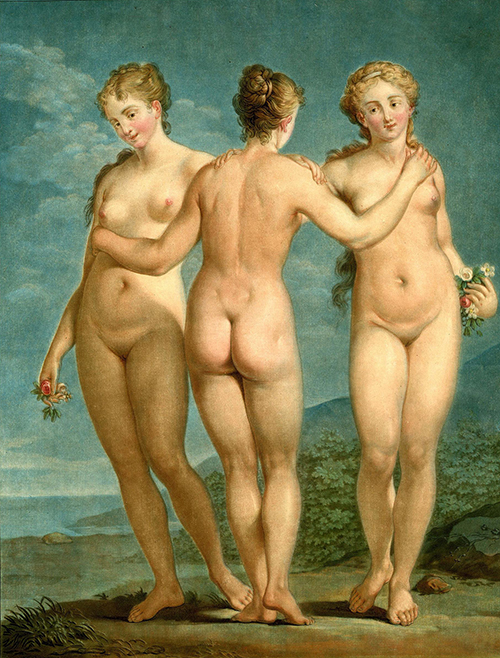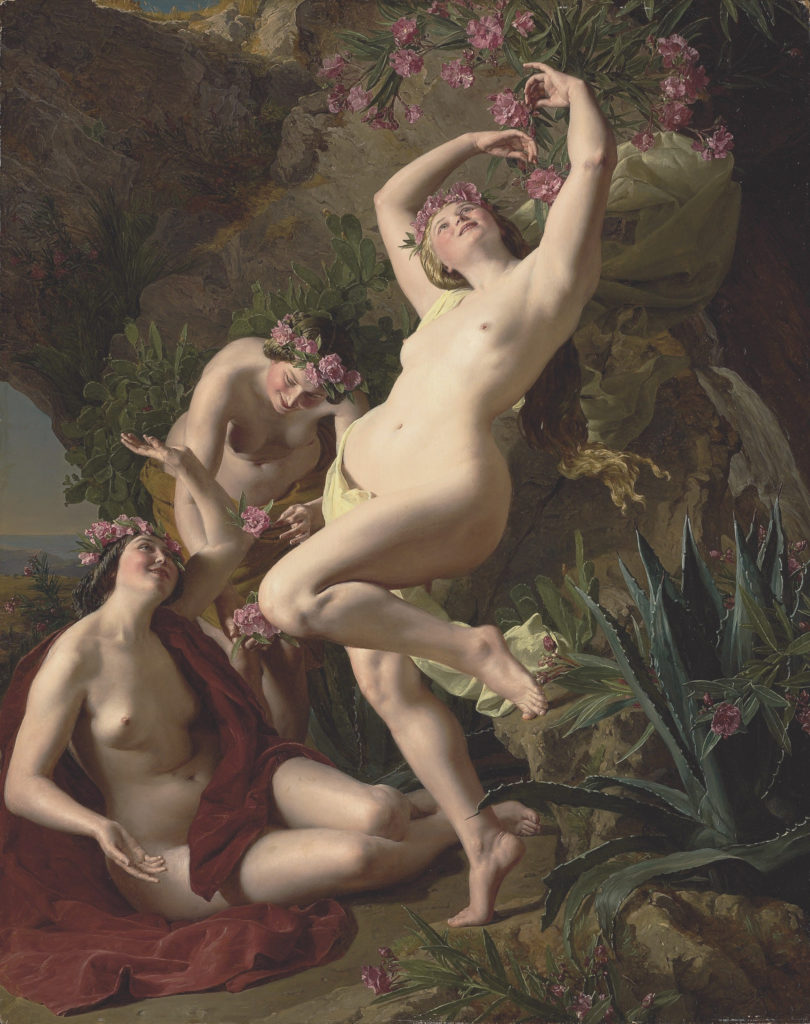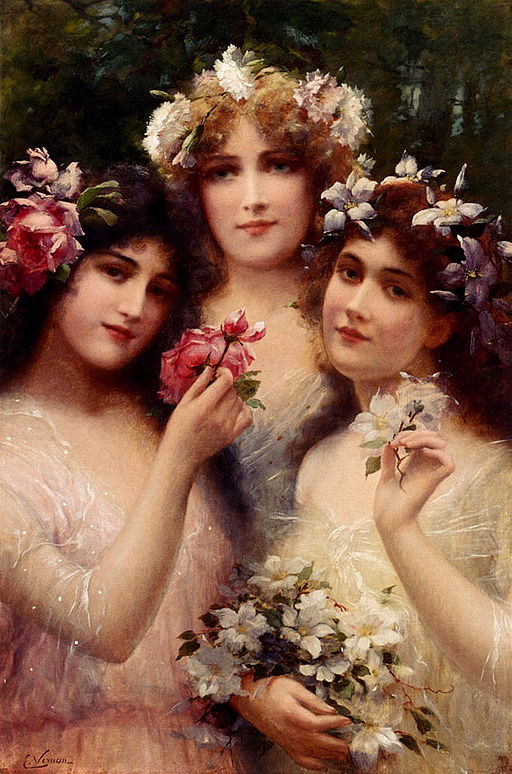2021.03.20 | By Gregory Nagy
§0. I focus here on a moment in history when the traveler Pausanias, who lived in the second century CE, visited the proud old city of Orkhomenos in the region of Boeotia. As we read in his report of that visit, he took a special interest in the traditional myths and rituals of the city’s inhabitants concerning goddesses worshipped there as the three Kharites or ‘Graces’. But how to visualize these goddesses? Pausanias experiences some difficulties here, as we will see. For one thing, the local population worships these goddesses in the form of three stones, quite bare and unadorned. As Pausanias reports (9.38.1), the natives of Orkhomenos say that these three stones had once upon a time fallen down to earth from the sky above. And so, as Pausanias observes (9.35.3), the question arises: why are there three such stones, three such ‘Graces’? And why was Pausanias, as he also observes (9.35.1), not told what names the local population might have in mind for each one of these three goddesses? To complicate matters further, Pausanias makes this additional observation about visualizing the ‘Graces’ of Orkhomenos in the form of three bare and unadorned stones: this aniconic visualization, he says (9.35.6–7), coexisted with alternative representations, both in sculptures and paintings, where these same goddesses are seen in the act of dancing naked with one another. At least, that was the case in the era of Pausanias, though our traveler adds (again, 9.35.6–7) that he knows of other sculptures and paintings attested in other places—and such works of art are sometimes older in date—where the ‘Graces’ are shown not naked but adorned in resplendent drapery. What, then, are we to make of such alternative visualizations?


§1. In a previous essay (Nagy 2021.03.06, linked here), I focused on a song composed by Pindar, who lived in the first half of the fifth century BCE, where the Kharites or ‘Graces’ of this same locale, Orkhomenos in Boeotia, are pictured as gracefully singing and dancing in a choral mode of song and dance known in Greek as the khoros. This song of Pindar, Olympian 14, was a choral performance celebrating the athletic victory of a young man from Boeotian Orkhomenos who had competed and won in the stadium-length footrace at the Olympics; the precise date of the Olympic year is in this case not known, but the general dating takes us back, in any case, to the early fifth century BCE—over six centuries before Pausanias. And I emphasize here a central assumption that is made quite clear in the wording of Pindar’s song—an assumption that is most relevant to the problems faced by Pausanias in his attempts at visualizing the ‘Graces’ of Boeotian Orkhomenos. As I showed in my previous essay (again, linked here), Pindar’s song pictures the ‘Graces’ as the divine regulators and ultimate models for the choral singing-and-dancing of the gods themselves, who are in turn the idealizing models for all choral performance, as we read in the wording of Pindar (lines 7–8): οὐδὲ γὰρ θεοὶ ϲεμνᾶν Χαρίτων ἄτερ | κοιρανέοντι χορούϲ ‘not even the gods can do without the sacred Graces [Kharites] in presiding-over ensembles of song-and-dance [khoroi]’.
§2. In my essay here, I return to such a graceful picturing of the ‘Graces’. And I will go further, by recalling other moments in the travels of Pausanias to other places where he too has encountered further variations on this theme of the ‘Graces’. One such moment stands out: it is when Pausanias, during his visit to Elis, site of the Olympics, fixes his gaze on a set of statues representing the three Kharites or ‘Graces’ (6.24.6–7) and engages in a reverie about the beauty and the pleasure radiating from these ‘Graces’, resplendent in their full bloom of youth. In this case, as I show in a previous essay (Nagy 2021.01.09, linked here), Pausanias goes out of his way to highlight the fact that two of these three goddess are actually holding flowers in bloom. As we will soon see, even the meaning of the noun kharites as ‘graces’ is relevant here, since this meaning can modulate into an actual visualization of flowers in bloom, occasionally plaited into garlands. There are many examples where the visual arts, both ancient and beyond, revel in the floral beauty of the ‘Graces’, and the colors red or white tend to predominate. These two colors, as we will also soon see, are relevant to the linking of the ‘Graces’ with flowers and with garlands made by way of plaiting flowers.


§3. Here I return to what Pausanias is saying about the ‘Graces’ of Boeotian Orkhomenos. I start with a detail: Pausanias reports that the custom of worshipping these goddesses known as the Kharites or ‘Graces’ was begun at Orkhomenos in Boeotia, according to the local myths, and that the first worshipper was a hero named Eteokles, a prototypical king of the city. Although Pausanias seldom uses first-person forms for self-reference in his writings about his travels, he feels moved to say in this exceptional case: παρὰ δὲ Ἐτεοκλέους τοῦ Ὀρχομενίου μαθόντες τρισὶν ἤδη νομίζομεν Χάρισιν εὔχεσθαι ‘It was from Eteokles of Orkhomenos that we by now have-the-custom [nomizein] of praying [eukhesthai] to three Graces [Kharites]’ (9.35.3). So, ‘we’ Greek-speaking people in ‘our’ own historical time traditionally pray to specifically three Kharites when we pray to the ‘Graces’. In the context of this reportage, however, Pausanias mentions other cases linked with locales other than Boeotian Orkhomenos where these ‘Graces’ are visualized as specifically two in number, not three (9.35.1–2); and there are still other cases where only a single ‘Grace’ or Kharis makes her divine presence felt (9.35.4–5). Nevertheless, Pausanias emphasizes that the Kharites of Orkhomenos, according to the local population, were the first ‘Graces’ ever to be worshipped by humans, since the prototypical king Eteokles of Orkhomenos was the first human ever to sacrifice to them: τὸν δὲ Ἐτεοκλέα λέγουσιν οἱ Βοιωτοὶ Χάρισιν ἀνθρώπων θῦσαι πρῶτον ‘The Boeotians say that Eteokles was the first human to sacrifice [thuein] to the Graces [Kharites]’ (9.35.1). And the hieron or ‘sanctuary’ where the ‘Graces’ are worshipped, Pausanias adds, is the oldest of all the sanctuaries in the city: τὸ δὲ ἀρχαιότατον Χαρίτων ἐστὶν ἱερόν ‘the oldest sanctuary [hieron] in the city is that of the Graces [Kharites]’ (9.38.1). So, by inference, the prototypical situation of the Kharites in Boeotian Orkhomenos leads Pausanias to accept the primacy of these local goddesses as the definitive version, as it were, of the Panhellenic idea of the Kharites or ‘Graces’ to whom all Hellenes—that is, all of ‘us Greeks’ in the era of Pausanias—can and do pray.
§4. Pausanias, in highlighting some Panhellenic aspects of the three Kharites, especially in terms of their triadic presence in Boeotian Orkhomenos, did not mention—and possibly did not even notice—the relevant evidence to be found in the wording of Pindar’s Olympian 14, where the numbering of the three ‘Graces’ is presented as an essential feature of the local goddesses of Boeotian Orkhomenos as divine models for the choral singing and dancing that symbolizes the idea of social integration as celebrated by Pindar’s victory ode. I return here to a relevant argument I presented in my previous essay, already cited (Nagy 2021.03.06, linked here): the word kharis, personified in Pindar’s Olympian 14 by the three goddesses known as the Kharites, actually refers to the beauty and the pleasure that derive from social integration—as symbolized by the choral song that is being performed in praise of the local athlete whose victory at the Olympics is now being celebrated in his own city, Boeotian Orkhomenos. As I also argued in my previous essay, even the naming of the three ‘Graces’ in Olympian 14 as Aglaíā (Ἀγλαΐα), Euphrosúnā (Εὐφροϲύνα), and Thalíā (Θαλία) at lines 13, 14, and 15 of Pindar’s song, together with their epithets, is an additional way of referring to the beauty and the pleasure of the choral performance that symbolizes the social integration that is signaled by the word kharis and by the tripartite personification of this word in the divine personages of the three ‘Graces’. When Pausanias (9.35.5), by contrast, refers to the three ‘Graces’ or Kharites in the Hesiodic Theogony, line 907 (Χάριτας, in the accusative), he is interested simply in the fact that all three are given names at line 909 there: Aglaíē, Euphrosúnē, and Thalíē (Ἀγλαΐην / Εὐφροσύνη / Θαλίην, all in the accusative). But he does not consider the symbolism of such names in the context of local celebrations, as for example brought to life in Pindar’s Olympian 14, where we can see clearly that the meanings of these divine names, just like the meaning of the word kharis itself, are relevant to the actual worshipping of these goddesses as models of social integration. In the Hesiodic mention of the three ‘Graces’, by contrast, all we see on the surface is the beauty and the pleasure that is personified by the names of the three goddesses, without the “local color.”
§5. In other contexts, however, Pausanias does in fact clearly see the “local color” that is potentially linked to the worship of the Kharites—even where these goddesses are not named individually for the sake of further personifying the idea of kharis as the beauty and the pleasure that emanate from local celebrations in song and dance. A case in point is what Pausanias saw when he visited Olympia, where the statues of the three ‘Graces’ displayed in the public space of Elis caught his attention (6.24.6–7). At §2 above, I already mentioned this moment in the reportage of Pausanias, referring to a previous essay of mine (Nagy 2021.01.09, linked here), but now I elaborate further, repeating what I argued at §14 in the previous essay I just cited.
§6. As Pausanias says (6.24.6-7), the statues of the Kharites or ‘Graces’ that he sees in the agora of the people of Elis are linked with roses and myrtles, since one of the three ‘Graces’ is represented as holding a rose while another of the three is holding a spray of myrtle. In the case of the mursínē or ‘myrtle’, as Pausanias calls it, I find it significant that the word kharis itself, which applies generically in this context to each one of the three ‘Graces’, can apply in other contexts specifically to the flower of the myrtle-tree. I quote from Scholia D (via Scholia A) for Iliad 17.51: Μακεδόνες δὲ καὶ Κύπριοι χάριτας λέγουσι τὰς συνεστραμμένας καὶ οὔλας μυρσίνας, ἃς φαμὲν στεφανίτιδας ‘Macedonians and Cypriotes use the word kharites [= plural of kharis] with reference to myrtle blossoms that are compacted and curled [around a garland]. We call them garland-blossoms [stephanitides]’ (from my MoM 4§§144–146; further comments in HPC II§424 pp. 295–296). Such a specific use of plural kharites in referring to myrtle blossoms is attested already in the Homeric Iliad (as I argued in HPC II§424 pp. 295–296). In Iliad 17.51–52, where the death of the hero Euphorbos is described, we see droplets of blood that grace the disheveled hair of the dead hero, lying in the dust, and these droplets are actually compared by way of simile to kharites, which in this context seem to be referring to red blossoms of myrtles: αἵματί οἱ δεύοντο κόμαι χαρίτεσσιν ὁμοῖαι | πλοχμοί θ’. Here is my translation: ‘with blood bedewed were his locks of hair, looking like kharites, | with the curls and all’. I draw attention here (following my comment in HPC II§425 p. 296n80) to a modulation from red to white coloring in the complex simile of Iliad 17.51–59, where the graphic description extends from lines 51–52, focusing on the red color of myrtle blossoms, to lines 53–59, focusing on the white color of olive blossoms.
§7. The transition from red to white in the Homeric simile here corresponds, I now think, to the fact that the blossoms of different kinds of myrtle trees can have different colors—either red or white.
§8. I conclude for now by contemplating once again what is surely the biggest question of them all for Pausanias in his quest to visualize the three Kharites or ‘Graces’ of Orkhomenos in Boeotia—those three aniconic stones that once upon a time fell to earth from the heavens above. The question is, are these ‘Graces’ really to be pictured as beautifully naked when we see them dancing with each other in choral song? Or, instead, are they beautifully adorned in resplendent drapery? The answer may be primally simple—if we think of the ‘Graces’ as a heaven-sent expression of earthly Nature. These goddesses, as the essence of natural beauty in all its floral varieties, do not need to wear resplendent drapery for their adornment: what already adorns their song and dance are the blossoms that they embody—red or white or any other color they choose.
§9. In their naturalness, however, the ‘Graces’ can also choose to wear beautiful clothing, just as easily as they can choose to go au naturel. And whatever these goddesses, adored as they are, choose to wear—or not wear at all—will be fashionably erotic. Such is the theology of their theo-eroticism.


Bibliographical Abbreviations
BA = Best of the Achaeans, Nagy 1979/1999.
GMP = Greek Mythology and Poetics, Nagy 1990b.
H24H = The Ancient Greek Hero in 24 Hours, Nagy 2013
HC = Homer the Classic, Nagy 2009|2008
HPC = Homer the Preclassic, Nagy 2010|2009
HQ = Homeric Questions, Nagy 1996b
HR = Homeric Responses, Nagy 2003
LSJ = Liddell, H. G., R. Scott, and H. S. Jones. 1940. A Greek-English Lexicon. 9th ed. Oxford.
MoM = Masterpieces of Metonymy, Nagy 2016|2015
PasP = Poetry as Performance, Nagy 1996a
PH = Pindar’s Homer, Nagy 1990a
Bibliography
Bundy, E. L. 1986 [1962]. Studia Pindarica. Berkeley / Los Angeles.
Muellner, L. 1976. The Meaning of Homeric EYXOMAI through its Formulas. Innsbruck. http://nrs.harvard.edu/urn-3:hul.ebook:CHS_MuellnerL.The_Meaning_of_Homeric_eukhomai.1976.
Nagy, G. 1979/1999. The Best of the Achaeans: Concepts of the Hero in Archaic Greek Poetry. Baltimore. Revised ed. with new introduction 1999. http://nrs.harvard.edu/urn-3:hul.ebook:CHS_Nagy.Best_of_the_Achaeans.1999.
Nagy, G. 1985. “Theognis and Megara: A Poet’s Vision of His City.” Theognis of Megara: Poetry and the Polis, ed. T. J. Figueira and G. Nagy, 22–81. Baltimore. http://nrs.harvard.edu/urn-3:hlnc.essay:Nagy.Theognis_and_Megara.1985. Corrigenda: at §77, “Pausanias 1.5.3 should be “Pausanias 1.5.4.”
Nagy, G. 1990a. Pindar’s Homer: The Lyric Possession of an Epic Past. Baltimore. http://nrs.harvard.edu/urn-3:hul.ebook:CHS_Nagy.Pindars_Homer.1990.
Nagy, G. 1990b. Greek Mythology and Poetics. Ithaca, NY. Revised paperback edition 1992. http://nrs.harvard.edu/urn-3:hul.ebook:CHS_Nagy.Greek_Mythology_and_Poetics.1990.
Nagy, G. 1994. “Genre and Occasion.” Mètis: Anthropologie des mondes grecs anciens 9–10:11–25. http://nrs.harvard.edu/urn-3:hlnc.essay:Nagy.Genre_and_Occasion.1994.
Nagy, G. 1996a. Poetry as Performance: Homer and Beyond. Cambridge. http://nrs.harvard.edu/urn-3:hul.ebook:CHS_Nagy.Poetry_as_Performance.1996.
Nagy, G. 1996b. Homeric Questions. Austin. http://nrs.harvard.edu/urn-3:hul.ebook:CHS_Nagy.Homeric_Questions.1996.
Nagy, G. 1999. See Nagy 1979.
Nagy, G. 2009|2008. Homer the Classic. Printed | Online version. Hellenic Studies 36. Cambridge, MA, and Washington, DC. http://nrs.harvard.edu/urn-3:hul.ebook:CHS_Nagy.Homer_the_Classic.2008.
Nagy, G. 2010|2009. Homer the Preclassic. Printed | Online version. Berkeley and Los Angeles. http://nrs.harvard.edu/urn-3:hul.ebook:CHS_Nagy.Homer_the_Preclassic.2009.
Nagy, G. 2011c. “A Second Look at the Poetics of Reenactment in Ode 13 of Bacchylides.” Archaic and Classical Choral Song: Performance, Politics and Dissemination, ed. L. Athanassaki and E. L. Bowie, 173–206. Berlin. http://nrs.harvard.edu/urn-3:hlnc.essay:Nagy.A_Second_Look_at_the_Poetics_of_Re-Enactment.2011.
Nagy, G. 2013. The Ancient Greek Hero in 24 Hours. Cambridge, MA. http://nrs.harvard.edu/urn-3:hul.ebook:CHS_NagyG.The_Ancient_Greek_Hero_in_24_Hours.2013.
Nagy, G. 2016|2015. Masterpieces of Metonymy: From Ancient Greek Times to Now. Hellenic Studies 72. Cambridge, MA, and Washington, DC. http://nrs.harvard.edu/urn-3:hul.ebook:CHS_Nagy.Masterpieces_of_Metonymy.2015.
Nagy, G. 2020.12.31. “About Aphrodite’s birds and her magical flowers in Song 1 of Sappho and elsewhere.” Classical Inquiries. https://classical-inquiries.chs.harvard.edu/about-aphrodites-birds-and-her-magical-flowers-in-song-1-of-sappho-and-elsewhere/.
Nagy, G. 2021.01.09. “The theo-eroticism of mythmaking about Aphrodite’s love for boys like Adonis.” Classical Inquiries. https://classical-inquiries.chs.harvard.edu/the-theo-eroticism-of-mythmaking-about-aphrodites-love-for-boys-like-adonis-in-ancient-greek-paintings/.
Nagy, G. 2021.03.06. “A sampling of comments on Pindar Olympian 14: highlighting Thalia as one of the three Graces.” Classical Inquiries. https://classical-inquiries.chs.harvard.edu/a-sampling-of-comments-on-pindar-olympian-14-thalia/.
